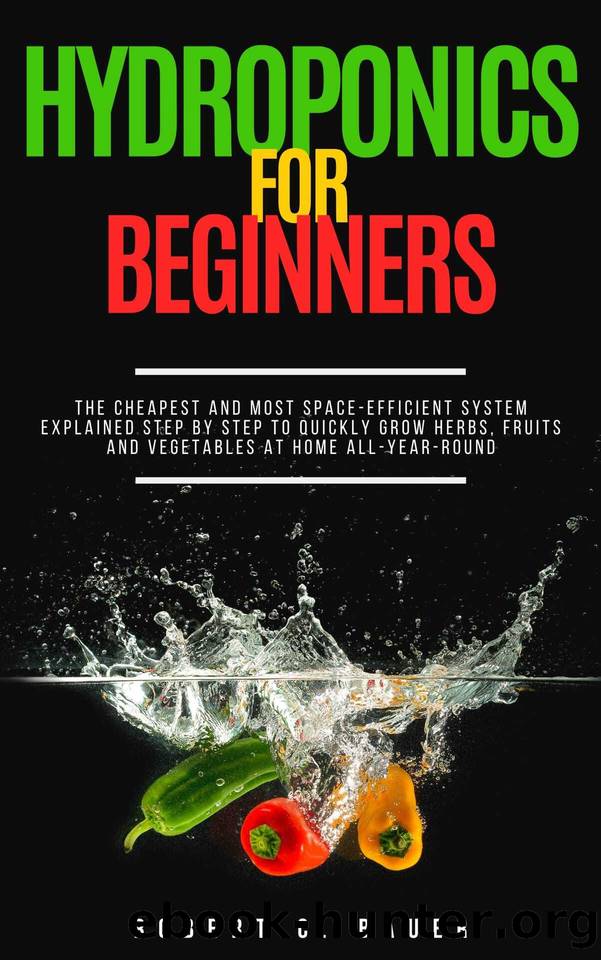Hydroponics for Beginners: The 7 Cheapest and Most Space-Efficient Systems Explained Step By Step to Quickly Grow Herbs, Fruits and Vegetables at Home All-Year-Round by Robert C. Bauer

Author:Robert C. Bauer [Bauer, Robert C.]
Language: eng
Format: azw3
Published: 2020-04-29T16:00:00+00:00
CHAPTER 5 – GROWING MEDIA
The search for the perfect growing medium escapes even the most experienced hydroponic growers. But with this simple guide, you will find it much easier to extricate yourself among so many different choices.
So, what are the characteristics of the perfect growing medium
_ Holds an even ratio of air and water.
_ Helps pH changes in the buffer over time.
_ Is flushed quickly and re-wets after being fully dehydrated, as would be the case during transport.
_ Is reusable or biodegradable, so that safe handling is assured.
_ Is cheap, affordable, and easy to get.
_ Should be lightweight and work both indoors and outdoors easily.
_
In most hydroponic gardens, soil-free growing media are mainly used to start seeds and to root cuttings. The narrower the medium a system requires, the simpler it is to run, and the less it costs. This is an important consideration for those who intend to make a profit out of their hydroponic gardens. Since river gravel and sand were used in early schemes, modern-day soil-free media have come a long way.
An ideal medium will accommodate a combination of air and water approximately equal. The plants require oxygen and nutrients to enter their roots, as you have discovered. Every medium's water/air holding potential is determined by the small spaces in between each granule or fiber. Such medium "holes" are known as "interstitial spaces." Fine sand is distinguished by very small interstitial spaces that cannot contain much air and water. Coarse gravel, on the other hand, has large interstitial spaces that can hold much of both air and water.
Yet, as science would have it, once the interstitial space becomes too big to hold the water in place for capillary action, you guessed it, the water runs right through. If your body continuously recirculates the nutrient solution, it would be necessary to have a fast-draining medium. But obviously, coarse gravel is not a good medium for a system that does not circulate nutrients to the plants constantly.
Let’s explore the qualities and downsides of some of the most common growing media.
Coco coir
My favorite growing loose medium is coconut coir, otherwise known as Ultrabeat, Cocopeat, and Coco-tek. Coco coir is a major advance in organic soil-free growing mediums. This incorporates Vermiculite water retention with perlite air retention. However it is a completely organic product made from shredded coconut husks.
How husks in coconut? The coconut husk serves its seed for two purposes:
1 protecting it from sun and salt while floating in the ocean;
2 providing a hormone-rich and fungus-free medium to speed germination and rooting after landfall.
Coconut coir, finely shredded and steam sterilized, offers plants an ideal rooting medium, which also provides protection against root diseases and fungi. And unlike peat moss, which is rapidly getting depleted from overuse, coir is a resource that can be completely renewed. There are now several variations of coir available on the market.
The most popular format is the compressed briquette, which requires soaking in a gallon of water before use. The coir re-hydrates during soaking, expanding to
Download
This site does not store any files on its server. We only index and link to content provided by other sites. Please contact the content providers to delete copyright contents if any and email us, we'll remove relevant links or contents immediately.
| Colder Climates | Desert |
| Temperate | Tropical |
Turbulence by E. J. Noyes(7660)
The Thirst by Nesbo Jo(6407)
Gerald's Game by Stephen King(4343)
Be in a Treehouse by Pete Nelson(3622)
Marijuana Grower's Handbook by Ed Rosenthal(3489)
The Sprouting Book by Ann Wigmore(3390)
The Red Files by Lee Winter(3251)
The Remains of the Day by Kazuo Ishiguro(3100)
Sharp Objects: A Novel by Gillian Flynn(2823)
Christian (The Protectors Book 1) by L. Ann Marie(2585)
Organic Mushroom Farming and Mycoremediation by Tradd Cotter(2546)
The Culinary Herbal by Susan Belsinger(2320)
Stone Building by Kevin Gardner(2274)
The Starter Garden Handbook by Alice Mary Alvrez(2180)
Lilac Girls by Martha Hall Kelly(2177)
The Unlikely Pilgrimage of Harold Fry by Rachel Joyce(2116)
The Lean Farm Guide to Growing Vegetables: More In-Depth Lean Techniques for Efficient Organic Production by Ben Hartman(1998)
Urban Farming by Thomas Fox(1970)
Backyard Woodland by Josh VanBrakle(1810)
